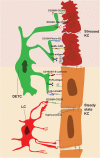Get in Touch With Dendritic Epithelial T Cells!
- PMID: 32849572
- PMCID: PMC7403176
- DOI: 10.3389/fimmu.2020.01656
Get in Touch With Dendritic Epithelial T Cells!
Abstract
Innate and adaptive immune systems continuously interchange information and orchestrate their immune responses to protect the host. γδT cells play crucial roles, as they incorporate both innate and adaptive immune characteristics. Dendritic epidermal T cells (DETC) are specialized γδT cells, which are uniquely positioned to rapidly respond to skin wounds and infections. Their elongated dendrite morphology allows them to be in continuous contact with multiple neighboring keratinocytes and Langerhans cells. Cellular interactions are fundamental to the formation, activation and maintenance of immune cell functions during steady state and pathology. Recent technological advances, especially in the field of cellular imaging, have contributed greatly to the characterization of complex cellular interactions in a spatiotemporally resolved manner. In this review, we will highlight the often-underappreciated function of DETC and other γδT cells during steady state and an ongoing immune response. More specifically, we discuss how DETC-precursors are shaped in the fetal thymus during embryogenesis as well as how direct cell-cell interactions of DETC with neighboring epidermal cells shape skin homeostasis and effector functions. Furthermore, we will discuss seminal work and recent discoveries made in the γδT cell field, which have highlighted the importance of γδT cells in the skin, both in humans and mice.
Keywords: DETC; activation; costimulation; epidermis; epithelial; γδT cell.
Copyright © 2020 Thelen and Witherden.
Figures


Similar articles
-
Differential requirement for CCR4 in the maintenance but not establishment of the invariant Vγ5(+) dendritic epidermal T-cell pool.PLoS One. 2013 Sep 12;8(9):e74019. doi: 10.1371/journal.pone.0074019. eCollection 2013. PLoS One. 2013. PMID: 24069263 Free PMC article.
-
Roles of γδT cells in pregnancy and pregnancy-related complications.Am J Reprod Immunol. 2021 Nov;86(5):e13487. doi: 10.1111/aji.13487. Epub 2021 Aug 9. Am J Reprod Immunol. 2021. PMID: 34331364 Review.
-
Regulation of skin cell homeostasis by gamma delta T cells.Front Biosci. 2004 Sep 1;9:2640-51. doi: 10.2741/1423. Front Biosci. 2004. PMID: 15358587 Review.
-
Development of dendritic epidermal T cells with a skewed diversity of gamma delta TCRs in V delta 1-deficient mice.J Immunol. 2000 Oct 1;165(7):3695-705. doi: 10.4049/jimmunol.165.7.3695. J Immunol. 2000. PMID: 11034374
-
TCR gamma/delta+ dendritic epidermal T cells as constituents of skin-associated lymphoid tissue.J Invest Dermatol. 1990 Jun;94(6 Suppl):58S-63S. doi: 10.1111/1523-1747.ep12875138. J Invest Dermatol. 1990. PMID: 1972173 Review.
Cited by
-
γδ T cell costimulatory ligands in antitumor immunity.Explor Immunol. 2022;2(1):79-97. doi: 10.37349/ei.2022.00038. Epub 2022 Feb 24. Explor Immunol. 2022. PMID: 35480230 Free PMC article.
-
TCR signaling and cellular metabolism regulate the capacity of murine epidermal γδ T cells to rapidly produce IL-13 but not IFN-γ.Front Immunol. 2024 Feb 28;15:1361139. doi: 10.3389/fimmu.2024.1361139. eCollection 2024. Front Immunol. 2024. PMID: 38482017 Free PMC article.
-
Tick extracellular vesicles undermine epidermal wound healing during hematophagy.bioRxiv [Preprint]. 2024 Sep 18:2023.11.10.566612. doi: 10.1101/2023.11.10.566612. bioRxiv. 2024. PMID: 37986907 Free PMC article. Preprint.
-
H19 promotes aerobic glycolysis, proliferation, and immune escape of gastric cancer cells through the microRNA-519d-3p/lactate dehydrogenase A axis.Cancer Sci. 2021 Jun;112(6):2245-2259. doi: 10.1111/cas.14896. Epub 2021 Apr 7. Cancer Sci. 2021. PMID: 33756038 Free PMC article.
-
Emerging roles of a chemoattractant receptor GPR15 and ligands in pathophysiology.Front Immunol. 2023 Jun 30;14:1179456. doi: 10.3389/fimmu.2023.1179456. eCollection 2023. Front Immunol. 2023. PMID: 37457732 Free PMC article. Review.
References
Publication types
MeSH terms
Substances
LinkOut - more resources
Full Text Sources

